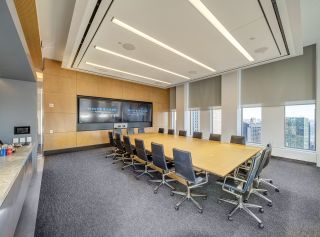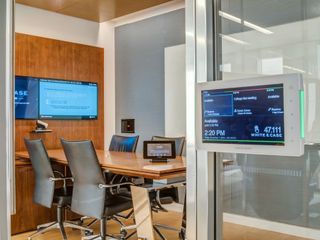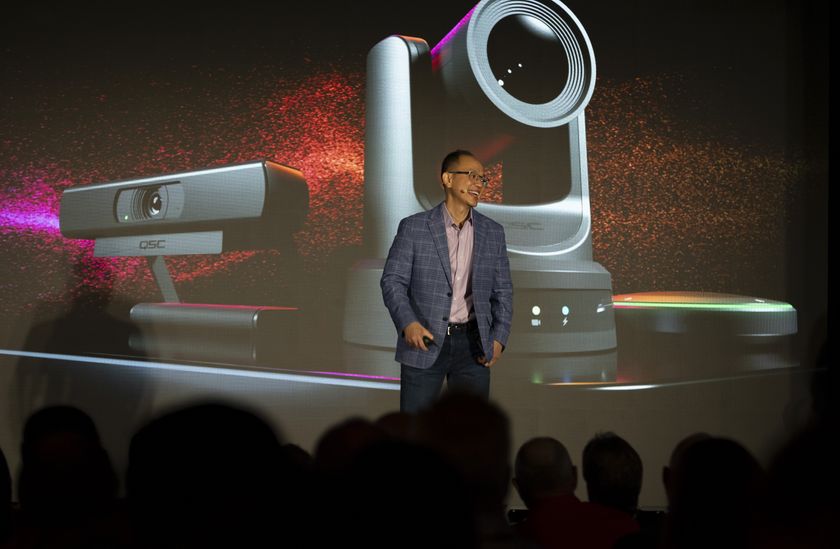White & Case LLP is a pioneering law firm with a global presence. Crossing borders and connecting communities, this global firm provides legal counsel to governments, companies, and financial institutions.

With more than 6,000 employees and firm expansion on the horizon, AV tools help White & Case teams to collaborate across its network of 44 offices in 30 countries. At all hours of the day, in any time zone, global audiovisual manager John Nunez and his team strive to make the AV performance reliable and easy to use, and the firm’s modern AV infrastructure keeps its systems running smoothly.
“Being global firm means technology is essential to maintaining a collaborative culture across our network of offices” Nunez said. “Our use of technology is essential to the success of our day-to-day operations.”
Nunez manages and leads a global team of 37 employees who support the AV needs of the firm’s partners and associates across all time zones.
The Business Case for AV
The growth statistics of White & Case’s AV services are impressive. As the firm continues to expand, so does its utilization of audiovisual technology.
“We continue to grow almost 20 to 25 percent annually on the utilization of videoconferencing, as well as audio conferencing,” Nunez said.
The firm recently relocated its New York City headquarters to a modern new office space in Midtown. Each element of the interior design and technology was selected to support team collaboration at the highest levels.
Thinking Global
The AV department operates under the Global Technology Services umbrella, where it collaborates with the IT team. IT and AV engineers consult closely to address day-to-day details as well as longer-term creative planning.

Global Technology Services initiated a “collaboration group” where representatives in both AV, telephony, network, and engineering could regularly trade ideas. “We collaborate a lot,” Nunez said. “Working closely together—we feel this will be the path to follow, technology-wise.”
The collaboration work group, of which Nunez is a part, drives core planning for the firm’s technology strategy. Priorities include networked AV, support, and making enterprise-grade deployments more efficient. From videoconferencing, to their work with mobility and WebRTC, this team ties everything together. The cross-pollination of skills and diverse range of perspectives gives the group dynamism.
Standardizing the Back and Front Ends
With a bevy of soft codecs available, Nunez emphasized the need to standardize as implementing cohesive standards helps remove guesswork for users.
“We started standardizing on the front end so our conference rooms have the same look and feel,” he said. “Now we're doing the same thing on the back end. We're standardizing all the technology that we offer. We don't want to offer a wide range of tools for our clients because that can get very confusing.”
Invest in Bridges, Internal Services
Focusing on internal solutions is another secret to White & Case’s technological success. “We have a vast infrastructure deployed,” Nunez said.
As part of that deployment, his team supports videoconferencing bridges. It manages its infrastructure, gateways, codecs, and webcasting. “We try not to use a lot of web-based solutions or cloud-based solutions,” he added.
Scale When Needed
While the cloud backbone is becoming more secure, for White & Case, the on-premise strategy is practice. “We keep a lot internal; it's been easier for us to manage,” he said. “We also have the right people doing the right jobs. We can provide further scalability and we can see where to concentrate more, when needed.”
The team doesn’t provide every technology service internally, however. Teaming up with an external audio conferencing partner frees up resources for higher-level endeavors.
Next-Level Rooms
Many of White & Case’s conference rooms offer built-in audio conferencing with most of the routing done internally. Its audio bridging partner provides the numbers, passkeys, and moderator codes for participants.
To enhance the employee experience and provide more tools, the AV team recently activated video functionality, so users can automatically trigger video capability to appear on the firm’s “super phone.”
Nunez is constantly thinking of ways to add efficiencies and and to center the user in all processes. A clever solution for video routing illustrates this dedication. The team enabled video routing between the infrastructures, which allows employees to dial into a videoconference room from their phones—or vice versa—to have a “face-to-face” conversation without having to utilize or occupy a bridge.
“That's been extremely successful—to dial what we call ‘the short dial’ internally,” Nunez said. “It's our short extension for a person, and I can dial somebody else as well as an extension and just get them on screens.” This routing hack might seem small, but when you multiply it by a few thousand, the efficiency gain is significant.
End to End
White & Case is utilizing Crestron equipment to handle everything from enterprise room scheduling, to lighting control, motorized shades, room control, and scheduling via TSW touchscreens. It has deployed DigitalMedia for AV distribution and AirMedia for wireless presentation, and is using Fusion for centralized monitoring.

“We've been using Crestron heavily for our backbone video distribution, control, and the core for our multipurpose rooms, and our global standard,” Nunez said.
Multipurpose Audio
White & Case is using Dante, specifically for multipurpose rooms, as the team found it was easier than running analog lines. It’s utilizing Dante to create multiple setups in the conference room, three or four in the divisible rooms, and enables Nunez and his team to easily deploy 30, 40, or 50 microphones to mounted receivers.
Focus on UX, Training
Many commercial verticals tackle similar issues, but for the legal sector, user experience is paramount. Nunez wants all employees to feel confident and comfortable using the AV technology.
“Adoption was a big challenge and a real struggle in the beginning.” With the global nature of the firm and so many hardworking partners and associates, system downtime is not an option. Nor is a lengthy training.
With a holistic framework in mind, the AV team studied the business to identify ways to deploy new technology hand-in-hand with training programs. The result: White & Case’s Conference Room Technology Program. The tech team also provides lunch-and-learn sessions.
“We really open the technology for partners and associates, and the general business as well,” Nunez said. “We have encouraged people to come in and use all the technology. If they break it, it's okay. We'll fix it. As people got more comfortable, we noticed that the technology was being utilized more and more.”
Of the 320 conference rooms globally, the AV team is about 50-percent complete with the new global standard’s rollout.
Smart Analytics Drive Deployment
“We believe in data and providing analytics,” Nunez said. “Our utilization has grown significantly in the previous years and continues to do so—this being the main driver for our focus on standards and technology adoption within our community.”
The strategic use of data has fueled the speed and scale of deployment. Not only does the team gather data, it provides most metrics to key stakeholders, to show the minutes of utilization every month, as well as usage in conference rooms via the firm’s global booking system.
New Tech Will Add New Value
Future plans include installing patches in every conference room and utilizing more motion sensors. If a room is booked but not occupied, the team knows it can release that room.
The other emerging technologies that add value to traditional AV configurations include self-booking services. Currently offered in its New York headquarters, self-bookable panels let anyone use a panel and book themselves for a period of time. This method eliminates the need to interface with the practice assistant (PA) or concierge.
Nunez also hopes to enhance the content sharing experience so anyone can visit a collaboration area with clients and automatically start sharing content wirelessly.
AV Improves Workflow
Having open collaboration spaces makes it easier and more intuitive for the user to take control of their own process. “We've had numerous associates come up to us and say, ‘Now you have an expert in this room. I don't need any assistance,’” Nunez said. “That’s what we want to hear. That’s the end goal for us, for the users to utilize the spaces that we've built.”
Invest in Cross-Training
For aspiring AV managers looking to advance in their careers, Nunez suggests studying IT processes and technologies.
“Cross-training is definitely key,” he said. “As we move forward in the industry, I'm sure there's no secret that at the end of the road, we're all going to be part of the same group. We're becoming more of network-driven and service-driven, rather than [just] support. Learning more about collaboration technologies as well as the networking aspect of things will certainly help.”
Margot Douaihy is the editor-at-large of AV Technology magazine.













